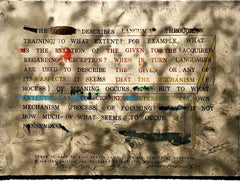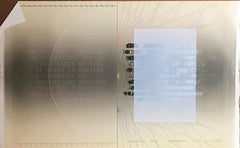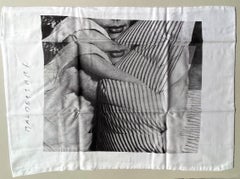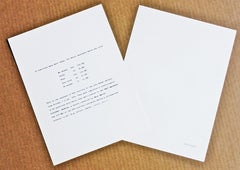Want more images or videos?
Request additional images or videos from the seller
1 of 11
Shusaku ArakawaArakawa, The Degrees of Meaning, from Realities and Paradoxes, Signed/N Framed1973
1973
$2,500List Price
About the Item
- Creator:Shusaku Arakawa (1936 - 2010, Japanese)
- Creation Year:1973
- Dimensions:Height: 36.25 in (92.08 cm)Width: 27.3 in (69.35 cm)Depth: 1 in (2.54 cm)
- Medium:
- Movement & Style:
- Period:
- Condition:Very good condition; not examined outside of frame. Minor waviness (see photo) otherwise a strong impression.
- Gallery Location:New York, NY
- Reference Number:1stDibs: LU1745215067892
About the Seller
5.0
Platinum Seller
Premium sellers with a 4.7+ rating and 24-hour response times
Established in 2007
1stDibs seller since 2022
451 sales on 1stDibs
Typical response time: 2 hours
Authenticity Guarantee
In the unlikely event there’s an issue with an item’s authenticity, contact us within 1 year for a full refund. DetailsMoney-Back Guarantee
If your item is not as described, is damaged in transit, or does not arrive, contact us within 7 days for a full refund. Details24-Hour Cancellation
You have a 24-hour grace period in which to reconsider your purchase, with no questions asked.Vetted Professional Sellers
Our world-class sellers must adhere to strict standards for service and quality, maintaining the integrity of our listings.Price-Match Guarantee
If you find that a seller listed the same item for a lower price elsewhere, we’ll match it.Trusted Global Delivery
Our best-in-class carrier network provides specialized shipping options worldwide, including custom delivery.You May Also Like
Triptychos Post Historicus Picasso Conceptual Art Silkscreen Gold Lithograph
Located in Surfside, FL
Braco D.
Slobodan "Braco" Dimitrijević (born 18 June 1948) is a Paris-based Bosnian and Yugoslavian conceptual artist. His works deal mainly with history and the individual's place ...
Category
1980s Conceptual Still-life Prints
Materials
Lithograph, Screen
Elaine Sturtevant, Duchamp Triptych - Three Signed Prints, Conceptual Art
Located in Hamburg, DE
Elaine Sturtevant (American, 1924-2014)
Duchamp Triptych, 1998
Medium: Two grano lithographs and one silkscreen, all on Rives rag paper
Dimensions: Each 50 x 40 cm (19.75 x 15.75 in)...
Category
20th Century Conceptual Abstract Prints
Materials
Lithograph, Screen
$3,492
H 19.69 in W 15.75 in
The New Year graphisms & 12. 1979, paper, silk screen, 15x21.5 cm
Located in Riga, LV
The New Year graphisms & 12. 1979, paper, silk screen, 15x21.5 cm
Maris Argalis (1954-2008)
Born in Riga.
1971. - graduated the Janis Rosenthal Riga Art...
Category
1970s Conceptual More Prints
Materials
Paper, Screen
$366 Sale Price
20% Off
H 5.91 in W 8.47 in D 0.04 in
Joan Brossa Spanish Artist, ¨Laberint¨, Silkscreen, 15.7x11.8 in
By Joan Brossa
Located in Miami, FL
Joan Brossa (Spain, 1919-1998)
'Laberint Poema visual de Joan Brossa', 1996
engraving, silkscreen on paper
15.8 x 11.9 in. (40 x 30 cm.)
Edition of 150
ID: BRO1205-005-150_3
Hand-sig...
Category
1990s Conceptual Abstract Prints
Materials
Paper, Engraving, Screen
$1,000
H 15.7 in W 11.8 in
Jupiter 7, Geometric Abstract Serigraph by Rafael Bogarin
By Rafael Bogarin
Located in Long Island City, NY
Artist: Rafael Bogarin
Title: Jupiter 7
Year: 1981
Medium: Serigraph, signed and numbered in pencil
Edition: 295
Paper Size: 22.5 x 28.5 inches
Category
1980s Conceptual Abstract Prints
Materials
Screen
$600
H 22.5 in W 28.5 in
Peking, Silkscreen by Kimura
By Risaburo Kimura
Located in Long Island City, NY
Artist: Risaburo Kimura, Japanese (1924 - )
Title: Peking
Year: 1973
Medium: Silkscreen on BFK Rives, Signed, titled and numbered in pencil
Edition: 250, AP 20
Size: 30 in. x 22 in. ...
Category
1970s Conceptual Abstract Prints
Materials
Screen
Aries from the Constellations Series, Silkscreen by Charles Ross
By Charles Ross
Located in Long Island City, NY
Artist: Charles Ross, American (1937 - )
Title: Aries from the Constellations Series
Year: 1979
Medium: Silkscreen, Signed and numbered in pencil
Edition: 150, AP XX
Image Size: 45 x...
Category
1970s Conceptual Abstract Prints
Materials
Screen
$2,000
H 57 in W 40 in
Scorpio from the Constellations Series, Minimalist Screenprint by Charles Ross
By Charles Ross
Located in Long Island City, NY
Artist: Charles Ross, American (1937 - )
Title: Scorpio from the Constellations Series
Year: 1979
Medium: Screenprint, Signed and numbered in pencil
Edition: AP 18/20
Image Size: 45 ...
Category
1970s Conceptual Abstract Prints
Materials
Screen
Tree in Tree (Green and Purple), Conceptual Art Screenprint by Menashe Kadishman
By Menashe Kadishman
Located in Long Island City, NY
Artist: Menashe Kadishman, Israeli (1932 - 2015)
Title: Tree in Tree (Green and Purple)
Year: 1979
Medium: Screenprint, signed and numbered in pencil
Edition: 125
Size: 41 x ...
Category
1970s Conceptual Abstract Prints
Materials
Screen
Tree in Tree (Burgundy and Gold), Conceptual Screenprint by Menashe Kadishman
By Menashe Kadishman
Located in Long Island City, NY
Artist: Menashe Kadishman, Israeli (1932 - 2015)
Title: Tree in Tree (Burgundy and Gold)
Year: 1979
Medium: Screenprint, signed and numbered in pencil
Edition: 125
Size: 41 x...
Category
1970s Conceptual Abstract Prints
Materials
Screen
More From This Seller
View AllUntitled 3 from "No!" Says the Signified" Silkscreen & Lithograph, Signed proof
By Shusaku Arakawa
Located in New York, NY
Shusaku Arakawa
Untitled 3 from "No!" Says the Signified, 1973
Lithograph and Silkscreen on Arches Paper with Deckled Edges
Hand signed and dated on the lower right front
Artist's Pr...
Category
1970s Conceptual Abstract Prints
Materials
Pencil, Lithograph, Screen
Blankless Tone, lithograph & silkscreen with embossing & folded corner. Signed/N
By Shusaku Arakawa
Located in New York, NY
Shusaku Arakawa
Blankless Tone, 1979
Color lithograph and silkscreen with embossing on Arches paper with deckled edges and folded collage upper left
Hand-signed by artist, Titled "Bl...
Category
1970s Conceptual Abstract Prints
Materials
Lithograph, Screen
Two Screenprinted pillow cases (one hand signed by Baldessari) in bespoke box
By John Baldessari
Located in New York, NY
John Baldessari Pillow Cases in Bespoke Presentation Box (one pillowcase hand signed by John Baldessari) for The Thing Quarterly Issue 22, 2014
Silkscreen on 100% cotton 320 thread count sateen pillowcases (Hand signed by John Baldessari)
Boldly signed in ink by John Baldessari on one of the pillowcases (see photo)
Unframed
One of the pillowcases is hand signed in ink by John Baldessari:
John Baldessari was one of the artists who were invited to contribute an object (or "thing") with text for a special project for "The Thing" publication (read on for more on "The Thing") ; the conceptual object therefore had to incorporate text. Baldessari's contribution in 2014 was a silkscreened pillowcase with text. A limited (unknown) number of these pillowcases were marketed and sold as a set of two in a bespoke box. However, exceptionally, Baldessari hand signed a very few of pillowcases in ink. This is one of the very special sets bearing one hand signed pillow case - purchased directly from "The Thing". (a copy of the 2014 receipt is shown here.) The rest of these boxed sets were not hand signed.
The pillowcase is brand new, and will look gorgeous once pressed and framed by a professional framer.
More about this boxed set:
Issue 22 of THE THING Quarterly is by LA-based conceptual artist John Baldessari. It consists of two 100% cotton sateen pillowcases featuring an image of a woman clutching a pillow. The black and white image is taken from a Hollywood film still in Baldessari's collection and has been silkscreened on each pillowcase with environmentally-friendly, water-based ink. The pillowcases are standard-sized and envelope-style. For those who like their thread count high, the issue clocks in at a solid 320 thread count.
Measurements:
Box
10.5 inches by 13 inches by 2 inches
Pillow
20 inches vertical by 26 inches
What was The Thing Quarterly?
THE THING was an experimental publication created in collaboration with Will Rogan as part of an artist residency. We saw it as a quarterly periodical in the form of an object. Each year, four artists, writers, musicians or filmmakers were invited to create an everyday object that somehow incorporates text. The object is reproduced and hand wrapped at wrapping parties and then mailed to the homes of the subscribers with the help of the United States Postal Service.
It began as part of an artist residency in San Francisco’s Southern Exposure. Will and I had met in grad school at UC Berkeley and discovered our mutual affinity for quarterlies. He was a librarian at SFAI for five years and I had been a high school teacher for five years. WE were both interested pushing the boundaries of publication. Our plan was to create a 1 year publication with four artists, but from the very start the project generated so much interest and international excitement that we found ourselves running a publication complete with a brick and mortar storefront and a staff of four individuals. After 10 years, 34 issues, 59 projects and countless live events, we decided to end the publication in order to pursue our individual projects. We are still working together on a less ambitious new project, and hope to launch it at some point in 2021.
CONTRIBUTORS: have included John Baldessari, Dave Eggers, Miranda July...
Category
2010s Conceptual Abstract Prints
Materials
Fabric, Cotton, Screen, Ink, Mixed Media, Cardboard
"If Elections Were Held Today" from the Castelli Sonnabend Collection
Located in New York, NY
Hans Haacke
"If Elections Were Held Today" from the Castelli Sonnabend Collection, 1973
Silkscreen in portfolio sleeve of Crane's bond paper No. 1. Stamped and numbered. Unframed in ...
Category
1970s Conceptual Abstract Prints
Materials
Screen
Joseph Beuys, Blatt auf Karteikarte, from Columbus: In Search of a New Tomorrow
By Joseph Beuys
Located in New York, NY
Joseph Beuys
Blatt auf Karteikarte (from Columbus: In Search of a New Tomorrow), 1992
Color silkscreen on vellum parchment paper, held in original portfolio sleeve
Signed by Eva Beuy...
Category
1990s Conceptual Abstract Prints
Materials
Vellum, Screen
NO SMOKING, Rare historic 1970s Fluxus hand pulled silkscreen mid century design
Located in New York, NY
Maciunas & George Brecht, George Maciunas, George Brecht
No Smoking, ca. 1973
Rare, historic Hand pulled Fluxus silkscreen
Limited edition and rarely found collectible (though exact number produced not known)
16 31/50 × 16 3/4 inches
Black and white hand-pulled silk screen by George Maciunas of George Brecht's iconic ”No Smoking” offset wallpaper squares
George Maciunas was a Lithuanian American artist, art historian, and art organizer who was the founding member and central coordinator of Fluxus, an international community of artists, architects, composers, and designers.
"George Maciunas had an extreme dislike of smoking. Being an asthmatic he could not tolerate it personally and with his complete devotion to Fluxus, professionally he felt there was no time or space for such a self-indulgent act. This disdain led fellow Fluxus artist, George Brecht to suggest a “no smoking” sign...
Category
1970s Conceptual Figurative Prints
Materials
Screen
Recently Viewed
View AllMore Ways To Browse
Roy Lichtenstein Plate
Ruth Alexander
Sam Francis Monotype
Steinberg Print Signed
Stephen Powers
Terry Rodgers
Tightrope Walker Vintage
Tom Levine
Vintage Sun And Moon Art
Voulkos Monotypes
Will Insley
Woodcut Braque
Yaacov Agam Original
Agam Metamorphosis
Agnes Martin Print
Albers Poster
Aleah Koury
Alesandro Ljubicic



